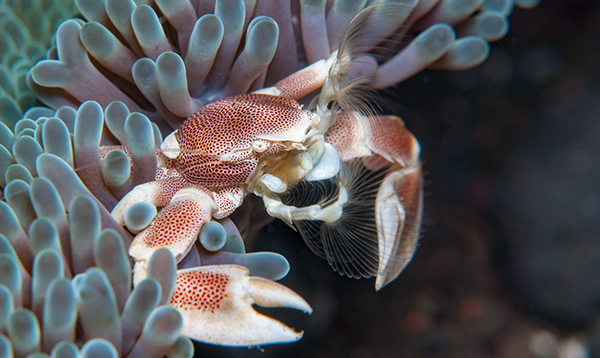Chalice Coral: A Comprehensive Guide for Beginners
Corals are not just beautiful creatures that add color to an underwater world, but they also play a vital role...
Jim Sabellico
December 30, 2022

Easy
Peaceful
Carnivore, Filter Feeder
72-78° F, dKH 8-12, pH 8.1-8.4, sg 1.023-1.025
Have you ever heard of a porcelain crab? This small, fragile-looking creature is one of the most beloved reef inhabitants. It can be a bit shy and reclusive, but it also plays an important role in keeping the reef healthy and thriving. Let’s take a look at some interesting facts about porcelain crabs and why they make great additions to reef tanks.
They are often referred to as “reef-safe” because they filter their environment while scavenging for larger meaty portions.
Porcelain crabs are very small creatures with body widths usually no greater than 15 millimeters. Their small size makes them ideal candidates for a reef tank, as they don’t require a lot of space or resources to thrive.
In addition, their diminutive size makes them unlikely targets for aggressive fish species, making them perfect tankmates for a variety of reef tank settings. They have two large claws for defense and feeding, and three pairs of walking legs. They have an interesting ability to regenerate lost limbs within weeks if necessary.
Porcelain crabs are quite active during the day but tend to remain hidden among the rocks and corals during nighttime hours. When threatened or startled, they will quickly retreat into crevices or hide beneath large rocks or pieces of coral, so it’s important not to handle them too much, as this can cause stress levels to rise significantly.
As long as there is plenty of hiding places, such as live rock, these creatures usually feel safe enough from predators that they will come out to explore their environment during the day.
Porcelain crabs can live up to 5 years in captivity if provided with ideal conditions such as high quality water parameters, ample food supply, and plenty of hiding places.
To ensure that your porcelain crab stays healthy throughout its life span, it is important to provide it with an adequate diet consisting mainly of meaty foods such as frozen shrimp and mussels along with some vegetable matter like seaweed sheets.
The Emerald Crab (Mithraculus sculptus) and the Porcelain Crab are both members of the family Porcellanidae, in which there are over a hundred different species. While they may look similar at first glance, there are some important differences between these two types of crabs.
To start with, let’s look at the size difference: The Emerald crab typically grows to between 1/2 – 2 inches in width while the Porcelain crab is usually around 1 inch wide. This means that the Emerald crab is much larger than its porcelain-crab counterpart.
Due to its bright green coloration, an emerald crab tends to be quite visible and active during low tide periods, unlike its camouflaged relative that remains hidden until after normal tides have receded from their habitats.
Perhaps most notably however is how each type of crab feeds: An emerald crab mostly relies on scavenging for food by way of detritus; dead organisms either decaying or washed up along shorelines as part of entanglement debris or floating refuse that becomes present near beaches and harbors due to human activities such as fishing operations or cargo ship collisions at sea.
Whereas porcelain crabs naturally filter plankton from nearby waters using hundreds of short hairs called “paleae” located within their chelipeds (claw-bearing appendages). This behavior gives them an edge because they don’t require energy expended searching for food sources like emeralds do.
If you want to know more about the Emerald Crab, this comprehensive article is an informational guide to care for this species: A Comprehensive Emerald Crab Care Guide
Porcelain crabs are truly remarkable species – both inside and out! Not only do they provide a unique aesthetic to any reef tank, but their filtering capabilities help keep the water clean while their regenerative abilities ensure that any injuries sustained in captivity can quickly heal themselves without leaving permanent damage.
No wonder porcelain crab has become such a beloved member of many reef tanks worldwide! If you’re looking for an interesting addition to your reef tank then consider adding some porcelain crabs – you won’t regret it!

I am the founder of J. Louis, a digital marketing agency focused on providing innovative solutions and strategies built on a foundation of creative design and technology. A family man who loves travel and reef tanks, I’ve been coined as a jack of all trades, master of a few of them, most specifically website and sales funnel design, monetization and growth strategies, and viral marketing. I began pursuing my passions for business by cutting my neighbor’s lawns when I was just 8 years old and never looked back. Over the past 20 years, I have amassed significant experience providing consulting, design and development services for Fortune 500 companies, government, retail, private individuals, and A-list celebrities.
Corals are not just beautiful creatures that add color to an underwater world, but they also play a vital role...
As we move into the new year, it's time to start thinking about what reef tank LED lighting kits will...

Proceeds from all purchases go directly to Great Barrier Reef Foundation and supporting their mission.
Want to stay connected with all the latest news in the Reef Tank Addict community? Drop your email below!
Proudly Supporting The Great Barrier Reef Foundation